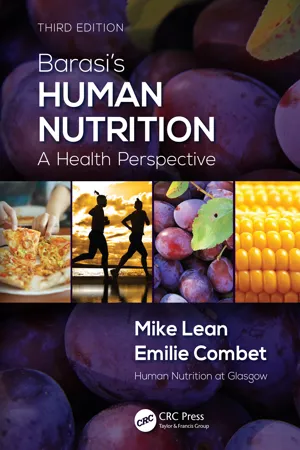
Barasi's Human Nutrition
A Health Perspective, Third Edition
- 456 pages
- English
- ePUB (mobile friendly)
- Available on iOS & Android
About this book
Barasi's Human Nutrition: A Health Perspective, Third Edition, provides a comprehensive introduction to the principles and practice of nutrition. Thoroughly revised, restructured, and updated, this new edition presents up-to-date scientific information in an accessible and reader-friendly format, emphasising how important nutrition is for evidence across the full translational health spectrum, from epidemiology and basic sciences through clinical and public heath applications, and ultimately into sustainable public policy.
This third edition places more emphasis on applied nutrition than previous editions. Specifically, sections relating to clinical nutrition, public health nutrition, and improving foods for better health are now separate chapters with new chapters on sport nutrition, obesity, and weight management, and each section has a dedicated table of contents to better highlight the subject covered. The book also focuses on nutritional issues related to globally important, potentially preventable, major diseases, such as coronary heart disease, cancer, and diabetes, and discusses methods for studying nutrition and relevant essential dietary principles for intervention.
This textbook is written from the perspective of experienced teachers at the undergraduate and graduate levels and is an invaluable resource for students in health and nutrition and for those pursuing further qualifications in food science. While containing substantial detail on some interesting topics, this book is written in an 'easy-read' style, which makes potentially complicated subjects accessible to general readers as well as to the more specialised user. It provides both an entry-level introduction to human nutrition for introductory or intermediate undergraduate students and also sufficient comprehensive detail to serve as a reference book for Masters or PhD students.
Frequently asked questions
- Essential is ideal for learners and professionals who enjoy exploring a wide range of subjects. Access the Essential Library with 800,000+ trusted titles and best-sellers across business, personal growth, and the humanities. Includes unlimited reading time and Standard Read Aloud voice.
- Complete: Perfect for advanced learners and researchers needing full, unrestricted access. Unlock 1.4M+ books across hundreds of subjects, including academic and specialized titles. The Complete Plan also includes advanced features like Premium Read Aloud and Research Assistant.
Please note we cannot support devices running on iOS 13 and Android 7 or earlier. Learn more about using the app.
Information
19 | Introduction to Public Health Nutrition and Health Promotion |
- Review and link some of the issues discussed in earlier parts of the book in relation to increasing health through improved nutrition.
- Consider some of the obstacles to improving nutrition that may exist.
- Describe strategies for health promotion and nutrition education that have been developed in recent years.
- Consider future directions.
- Reductions in maternal and infant mortalities
- Better control of infectious diseases through immunization and environmental improvements, although the spread of HIV infection has run counter to this trend
- Increased population life expectancies owing to advances in medical technology and lifestyle changes
- Improvements in diets in some areas
- Reduce inequalities in access to healthy food, as stated in Health 2020.
- Ensure human rights and the right to food.
- Empower people and communities through health-enhancing environments.
- Promote a life-course approach.
- Use evidence-based strategies.
Table of contents
- Cover
- Half Title
- Title Page
- Copyright Page
- Contents
- Preface
- Acknowledgements
- Authors
- Section I Foods, Nutrient Requirements and Nutrition
- Chapter 1: Introduction What is Nutrition?
- Chapter 2: Nutrient Requirements and the Nutritionally Balanced Diet
- Chapter 3: Macronutrients in Foods and Diets Proteins, Carbohydrates and Fats
- Chapter 4: Vitamins and Phytochemicals
- Chapter 5: Minerals, Electrolytes and Fluid
- Section II Nutrition through the Life Cycle
- Chapter 6: Nutrition during Pregnancy and Lactation
- Chapter 7: Nutrition during Infancy, Childhood and Adolescence
- Chapter 8: Nutrition during Adulthood and Ageing
- Section III Digestion, Absorption and Nutrient Metabolism
- Chapter 9: Gut Structures, Functions and Control of Digestion
- Chapter 10: Digestion and Absorption of Nutrients
- Chapter 11: Metabolism and Function of Macronutrients
- Chapter 12: Metabolism and Function of Micronutrients
- Section IV Eating Behaviour and Nutritional Epidemiology
- Chapter 13: Habits and Influences on Eating Behaviours
- Chapter 14: Diet and Coronary Heart Disease
- Chapter 15: Diet and Cancer
- Section V Dietary and Nutritional Assessment
- Chapter 16: Energy: Intake and Expenditure
- Chapter 17: Energy Balance
- Chapter 18: Dietary and Nutritional Assessment
- Section VI Applied Nutrition
- Chapter 19: Introduction to Public Health Nutrition and Health Promotion
- Chapter 20: Introduction to Obesity and Weight Management
- Chapter 21: Introduction to Clinical Nutrition
- Chapter 22: Introduction to Sport Nutrition
- Chapter 23: Improving Foods for Better Nutrition
- Index